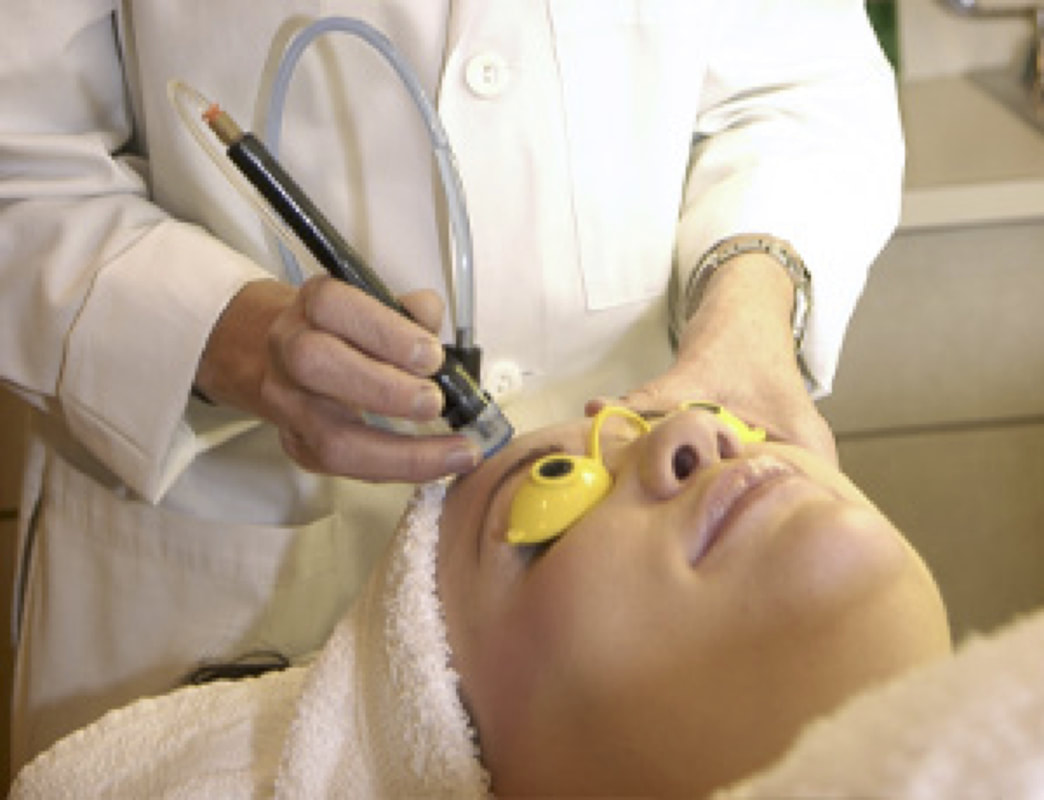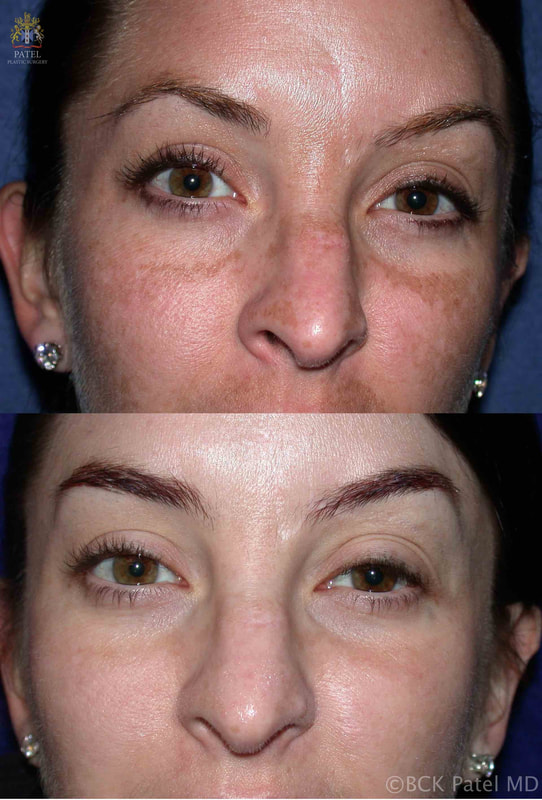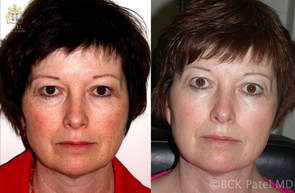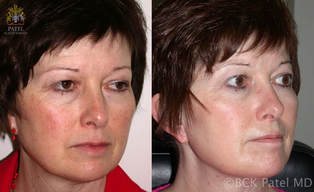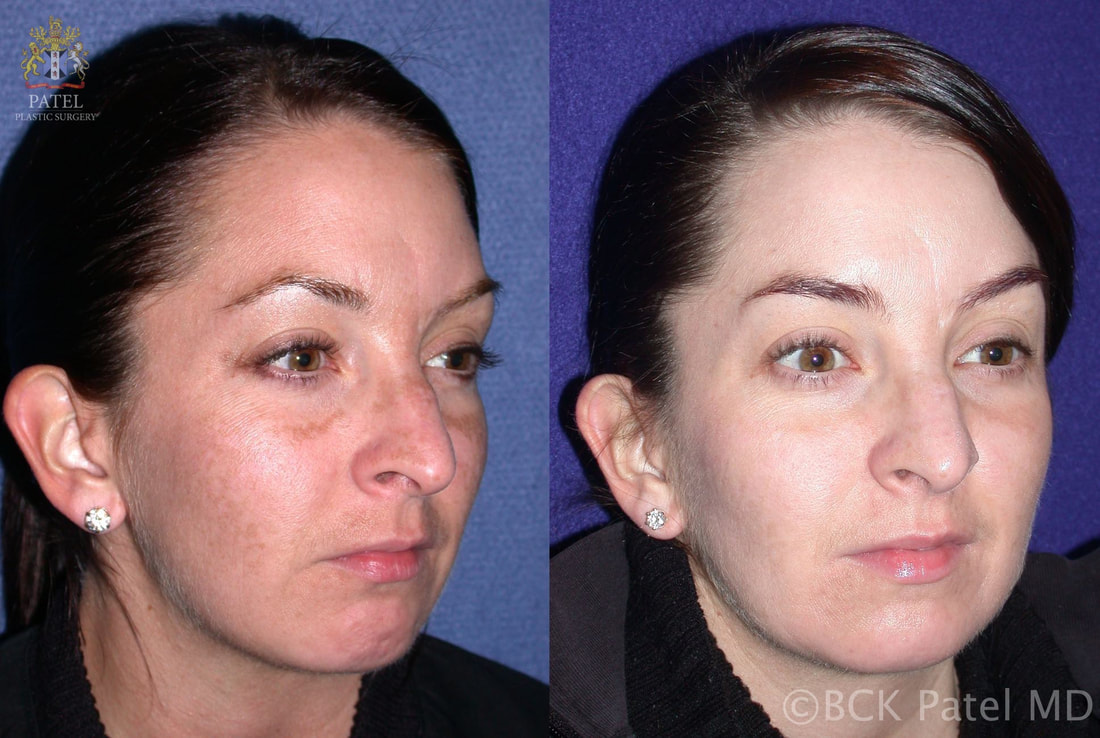What are light chemical peels and microdermabrasion used for?
|
Light chemical peels and microdermabrasion are most commonly used for:
|
What do microdermabrasion and light chemical peels treat?
They are both methods of superficial exfoliation that remove dead or damaged skin cells, refine the texture and color of your skin, help minimize fine lines, and clean out pores to improve acne. They can also help with melasma and some small scars. They do not help with deeper wrinkles, lines of expression (like frown lines), or serious sun damage.
Microdermabrasion is often used in conjunction with laser photorejuvenation treatments to help even out color and remove brown spots. It is more effective than home scrubs.
Microdermabrasion is often used in conjunction with laser photorejuvenation treatments to help even out color and remove brown spots. It is more effective than home scrubs.
What is microdermabrasion (MDA)?
|
Microdermabrasion is a method by which very fine crystals are vacuumed across the skin under pressure with a tiny vacuum-cleaner-like tip. The newer systems don’t use crystals but instead tiny diamond chips embedded in the tip to provide the abrasion. It’s nice to use the newer crystal-free systems but not essential.
Also, the newer systems offer the ability to infuse therapeutic agents at the same time that the microdermabrasion is being performed. For example, an aesthetician can infuse a solution of salicylic acid, which helps to clean out the pores while the microdermabrasion is working. Or, hyaluronic acid, could be infused to add extra moisture. Microdermabrasion can cause irritation or inflammation if the microdermabrasion is too aggressive for your skin type.Depending on how much acne or pigment you have and how sensitive your skin is, approximately five microdermabrasions are done one to four weeks apart, followed by a maintenance treatment about every four to eight weeks. You may have seen the terms Parisian peel, diamond peel, or lunch-time peel. Most of these all refer to the same process microdermabrasion. |
"Well, the last time I had a picture taken I could hardly see my eyes because of the weight of heavy eyelid. Then I paid attention to how I was actually using my eyes and I really noticed when I was looking at anything especially the computer I was straining my forehead to see better. Since I have had it done I no longer have to lift the forehead and tilt my head to see. It is amazing! I love..." D. Rock 63 Yrs Old with Fat Droopy Eyes - Salt Lake City, UT
What are light chemical peels?
Light chemical peels exfoliate the superficial layers of your skin to help remove dead and damaged surface skin cells, refine the texture and color of your skin, and help improve acne. There are many different names for these peels but most contain hydroxy acids, either alpha hydroxy, beta hydroxy or combinations of both. Many of these peels contain glycolic acid (alpha) or salicylic acid (beta).
Like microdermabrasion, they are usually gentle enough that you can go right back to your daily activities.
Like microdermabrasion, they are usually gentle enough that you can go right back to your daily activities.
How often should I get microdermabrasion (MDA) or light chemical peels?This really depends on your skin. If you are very oily and acne-prone, you may want to get a series or two every year with maintenance treatments every 4 weeks. For others, a series (usually 3-5 treatments) followed by a maintenance treatment every couple of months might be plenty.
|
When will I see results with MDA or light chemical peels?
Your skin will look and feel better immediately after a treatment. If you are acne prone, continued treatments
will help to keep the pores unclogged.
will help to keep the pores unclogged.
How much do microdermabrasion and light chemical peels cost?
MDAs and light chemical peels are often priced by the area, such as the face, neck, chest, upper back and discounts are often given if you purchasing a series so it’s difficult to say exactly. A single treatment of face might be $75-150 with a series of 5 in the range of $300-600.
"I had a excellent eye lift done by Dr. Patel. He knows what he is doing and is very pleasant. Dr.Patel was easy to get an appointment and he works with you. The office staff was very pleasant and made you feel calm." D. Gull Highly recommended for eye lift surgery - Salt Lake City, UT
Do the treatments hurt, and how long will they take?
For microdermabrasion, there is a mild pulling sensation (that tiny vacuum cleaner) during the treatment and a gentle, sandpapery feel. Most patients notice just mild discomfort.
For light chemical peels, there is mild stinging for a few minutes. The treatments usually take 30 to 60 minutes, depending on what else is being done.
For light chemical peels, there is mild stinging for a few minutes. The treatments usually take 30 to 60 minutes, depending on what else is being done.
What will I look like right after treatment, and what
will the healing time be?
Generally, the skin may look slightly pink for one to two days after the treatment, although not everyone experiences this. Check with your aesthetician, but makeup can be used starting right after the treatment as long as it is applied over a moisturizer and removed very gently.
You will need to increase your use of moisturizers during the treatment period as your skin will be slightly drier temporarily. Be sure to use sunscreen every morning.
You will need to increase your use of moisturizers during the treatment period as your skin will be slightly drier temporarily. Be sure to use sunscreen every morning.
Prior to the treatment.
Discontinue use of Retin-A/Renova or daily glycolic acid a few days prior to light chemical peels.
Postpone treatment if an active herpes (cold sore) outbreak exists or if you plan to be exposed to
strong sunlight in the next week.
Postpone treatment if an active herpes (cold sore) outbreak exists or if you plan to be exposed to
strong sunlight in the next week.
Immediately after the treatment.
- Moisturizers and sunscreen will be applied before leaving the treatment room.
- Moisturize and re-apply sunscreen (at least an SPF 15 with 5-10% zinc or titanium or 3% mexoryl) several times during the day as needed.
- Your skin may feel like you had a slight windburn or sunburn. Maintain hydration both topically and internally (drink plenty of water).
- Avoid direct sunlight for a week.
- Avoid Retin-A and glycolic acids for two-three days after the peel.
- Avoid swimming in chlorinated pools for a few days before and after (chlorine is very drying). Always avoid tanning beds.
- Avoid waxing of the treated area for at least one week; areas may be sensitive to waxing for up to one month after treatment.
What are the possible medical or cosmetic side effects?
|
MDAs and light chemical peels are generally quite safe when performed by an experienced, licensed aesthetician or a medical provider like an MA or an RN.
Burns have occurred though if peel solutions were too strong or left on too long. These are usually superficial and heal well. Rarely, permanent scarring or pigment problems have occurred. MDA, if done too aggressively, can irritate, cause redness and inflammation and an increase in fine lines (temporary). Both can activate cold sores as mentioned above. You will also be temporarily more sun sensitive so be sure to use sunscreen daily and more often if outdoors. |
Schedule Your Consult Today |
|
Visit Patel Plastic Surgery on YouTube for more free tips!
Stay Connected With Us On Social Media
|
Find UsLocations:
Dr. BCK Patel MD, FRCS 1025E 3300S Salt Lake City, Utah 84106, USA (801) 413-3599 (phone/text) E: [email protected] bckpatel.info Dr. BCK Patel MD, FRCS 585 E Riverside Dr Suite 201 Saint George, UT 84790 (435) 215-0014 E: [email protected] Quick-Link |
Let Us answer your questions |

